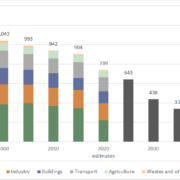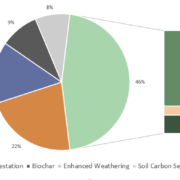How much carbon do we need to take out of the atmosphere? Current global scenarios
Net zero targets are taking centre stage in climate policy and action. Depending on the speed of emissions reductions in the coming years and the ambition level of climate goals, negative emissions and thus carbon removal from the atmosphere will be instrumental for achieving those targets. To get a better picture of the scale required we dig into the latest global reports on Net Zero scenarios.
Net Zero terminology
Even after aggressive emission reduction have taken place, residual emissions might still occur. Greenhouse gases must then be actively removed from the atmosphere in order to further reduce emissions on balance. A country or organisation achieves net zero emissions or climate neutrality when the amount of emissions removed reaches that of the residual emissions, i.e. when no more greenhouse gases are released into the atmosphere on balance. Emissions removed from the atmosphere are also called negative emissions. Various negative emissions technologies exist, which today mainly focus on the removal of CO2 as the most important greenhouse gas from the atmosphere, hence the focus on carbon removal.
Here it is necessary to differentiate between carbon removal, carbon capture and storage (CCS) and carbon capture and use or utilisation (CCU). CCS prevents emission from fossil fuels from entering the atmosphere in the first place, but does not remove any emissions from the atmosphere. In that respect it is not a negative emissions technology or solution. CCU refers to the use of captured CO2 in the production of fuels or other products. If a particular CCU process and product actually leads to negative emissions or not depends on where the captured CO2 comes from and on the life-time of the product in question. Figure 1 explains the difference between carbon removal, CCU and CCS.

Clearly, terminology is important when it comes to setting and specifically achieving credible Net Zero targets or climate strategies as well as when evaluating Net Zero claims or scenarios.
Assessing global scenarios
Given the vast amount of global climate scenarios and modeling exercises we only focus on a few of them in the following. Figure 2 shows an exemplary emission pathway for achieving 1.5°C, while at the same time showing traditional mitigation technologies, such as renewables and energy efficiency and carbon removal separately. The figure is based on data from the Network for Greening the Financial System (NGFS) climate scenarios for central banks and supervisory authorities.

In order to widen the scope of the analysis and to reduce the risk of looking in only one direction, we included scenarios of five different organisations:
The International Energy Agency’s (IEA) Net Zero by 2050 Roadmap, the Consultation Paper Reaching climate objectives: the role of carbon dioxide removals by the Energy Transitions Commission (ETC), the Special report: Global warming of 1.5°C of the Intergovernmental Panel on Climate Change (IPCC), McKinsey’s Climate math: What a 1.5-degree pathway would take and NGFS’s Climate scenarios. A few numbers on the relevant amount of negative emissions has been distilled from the report The case for Negative Emissions by the Coalition for Negative Emissions. We are aware that this selection only captures part of the available literature.
All scenarios considered aim to keep the temperature increase below 1.5 °C compared to pre-industrial levels. Still, comparing scenarios and studies is difficult due to different assumptions on which part of the economy and thus which emissions are included in the scenario or what exactly qualifies as carbon removal and what does not. In addition, the probabilities in keeping below a certain temperature threshold differ between scenarios and studies.
All of the above shows that increasing attention needs to be paid to making modeling and scenario assumptions for Net Zero as clear as possible in order to understand the implications of the scenario outcomes.
Rapid scale-up of carbon removal needed
What do the scenarios have in common?
Emission reductions from large-scale deployment of renewables and electrification of large parts of the industrial and transport sectors are included in all scenarios. Yet, all scenarios agree that there is a significant need for negative emissions in the gigatonnes (Gt CO2eq) range to achieve the 1.5°C climate target, as Figure 3 shows (data sources: Coalition for Negative Emissions, IEA).
Also, carbon removal technologies have to be available on a large-scale basis already during this decade and reach the Gt level by about 2030 from a very low level today. Given today’s greenhouse gas emissions of almost 50 Gt per year, the removals needed according to the five scenarios in 2050 amount to about 5 to 20 per cent of current global emissions. This is a stark reminder that negative emission technologies are not marginal implementations and potential fixes on the race to Net Zero, but important requirements to deal with residual emissions in laggard and hard-to-abate sectors.
Where do the numbers disagree and why?
On the upper end are the high range numbers of the ETC and the IPCC with up to 10 GtCO2eq of carbon removal by mid-century, while the IEA’s Net Zero Roadmap features on the lower end with an expected need of 2.4 Gt of negative emissions by 2050. The IEA foresees a total capture of 7.6 Gt including CCS and CCU. However, removals from the atmosphere make up only about 30 per cent of those. Also, the scenario assumption of the IEA include no new investments into unabated coal power plants and new oil and gas fields or coal mines from 2021 onwards, as well as the phase-out of unabated coal power globally by 2030. The level of ambition for classical mitigation strategies is very high here compared to the other four scenarios.

If a medium pathway such as in the NGFS or McKinsey scenarios is taken seriously, that means that negative emission technologies (NETs) need to be scaled up rapidly within the coming decades to achieve a removal potential in the Gt scale. A scale-up of at least 50 times from the present days is needed for that according to The case for Negative Emissions report. Especially as the current pipeline for carbon removal projects including Natural Climate Solutions, Bioenergy with CCS and Direct-Air-Capture until 2025 only stands at about 0.15 Gt (source: Coalition for Negative Emissions).
Implications for policy
To achieve net zero by 2050 while keeping global temperature below 1.5°C will require unprecedented efforts and are seemingly not plausible any longer without large-scale utilisation of carbon removal. Indeed, even many 2-degree pathways hinge on negative emissions although on a lower level, especially if international climate action falls short of more ambitious action (source: Minx, et. al., Fuss et. al.).
This leaves policy makers with many questions, such as:
- Which ways exist to integrate carbon removal in climate policy?
- What is the interaction between emission reduction and removal policy?
- How to scale-up NETs and innovation in the sector?
- Where to focus investments and resources?
- How to implement carbon removal credits and how to integrate them into the emission trading systems such as the EU ETS?
On the EU-level the first initiatives are on their way to support carbon removal, such as the Negative Emissions Platform and the European Commission wants to propose a robust carbon removal certification system by 2023. In addition, research and innovation on carbon removal are being funded by Horizon 2020 and the follow-up program Horizon Europe. The Innovation Fund, which receives 10 billion EUR from the income of the EU Emission Trading System, includes the commercial demonstration of low-carbon technologies, such as carbon removal and CCS into its framework.
As an example of how increased climate ambition leads to negative emissions is the case of the German new climate law. In a forthcoming article, we will have a closer look at the need for carbon removal in Germany’s road to greenhouse gas neutrality.
How is the industry preparing?
For the private sector, especially for corporations and companies that set climate targets and aim to go for their own net zero goals, the complexity of the discussion rises. Internationally acknowledged standards of setting climate targets and the role removals and reduction play within those such as the Net Zero Standard by the Science Based Targets initiative will be of great importance (source: SBTi).
Industry-led initiatives on voluntary carbon markets such as the Taskforce for Scaling Voluntary Carbon Markets (TSVCM), where cr.hub is part of the consultation group are needed as well to drive the demand and market. The TSVCM just launched their report of Phase II of implementing an industry-wide carbon market. However it is important that only high-quality removals feature in those industry-led initiatives in order to achieve real climate benefits. The discussion of what a high-quality removal actually entails, is a story for another time. We will come back to that in further articles.
In conclusion it becomes clear thatmany players and organisations are taking carbon removal and negative emissions now much more seriously in their climate and energy modelling scenarios and as a potential tool for reaching net zero targets. In addition, NETs have to be scaled dramatically in order to achieve the required removal potential.
Get in touch with us to learn more or subscribe to our newsletter.







Leave a Reply
Want to join the discussion?Feel free to contribute!